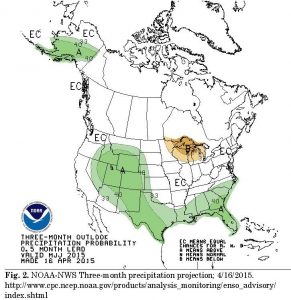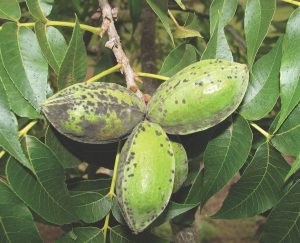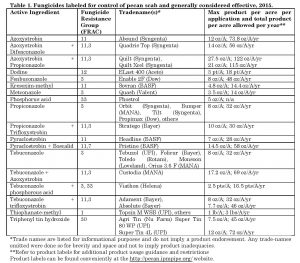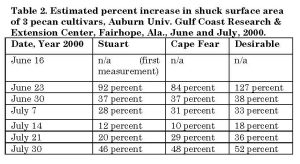Summer Pecan Scab Defense
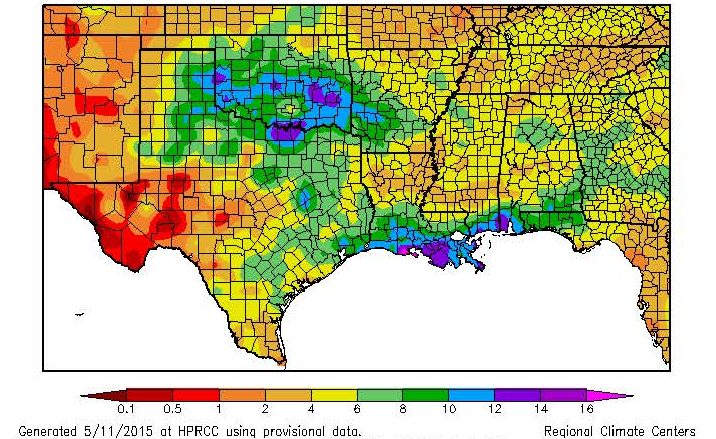
Rainfall (inches) from 4/11/2015 to 5/10/2015. NOAA, NWS.
El Nino tends to increase precipitation in the Southeast during the cool season (winter/spring), with lesser effects on summer rainfall. The 3-month outlook for precipitation issued by NWS on April 16, predicts above-average rainfall in South Georgia and Florida, with more normal rainfall elsewhere in the Southeast (Fig. 2). Rainy periods in the early growing season intensify problems with pecan scab, the most important fungal disease of pecan leaves, stems and nuts (see photo). Rainfall complicates scab control from 3 angles: 1) increased wetting of foliage and nuts means better conditions for fungal infection and epidemics, 2) fewer favorable opportunities to spray fungicides and more difficulty getting spray equipment into the orchard, and 3) more grass and weed growth, which prolongs drying time and raises humidity in the orchard. For these reasons, pecan growers in the Southeast are now on the defensive against scab.
The effects of scab include reduced leaf growth, leaf drop, stem dieback, nut drop, reduced nut size and reduced kernel percentage. The damaging period is from budbreak to shell hardening. Leaves are at risk when they are soft and expanding. Glossy, toughened leaves are not susceptible. Shuck tissue can be attacked throughout the growing season, but is of greatest concern during the rapid nut sizing period in June and July. Shuck infections after shell hardening are usually not economically damaging.
Pecan scab is a “polycyclic” fungus, meaning it has numerous infection cycles each season. A wet April means more inoculum and thus more potential for infections and crop damage in subsequent summer months. Brenneman (2005) demonstrated that early fungicide sprays during the pre-pollination period are critical to managing scab later in the summer in a year of high pressure, and less so if the pre-pollination period is dry. A study by Sparks, et al. (2009), in Georgia, found that rainfall in April when tabulated with rainfall from June to August gave the best prediction of scab effects on nut size. Above-average rainfall in April and May sets up pecan orchards for a pitched battle with scab if rainfall in June, July and August continues to be average or above average.
Scab will occur on susceptible pecan varieties, when the fungus is present and the conditions are favorable. There is no doubt about the presence of the fungus in all pecan orchards in the Southeast. Pecan cultivars vary widely in susceptibility, and thus control efforts must be greater for more susceptible cultivars like ‘Desirable’. Scab infection should be thought of as a 2-step process:
Step 1 – Germination of scab spores requiring free moisture on the plant tissue surface (Latham & Rushing, 1988).
Step 2 – Growth of the fungus into the pecan tissue, which requires dissipation of that free moisture but high relative humidity (Yates, et al., 1996).
Rain, fog or dew during warm weather that wets the leaves and nuts for 10-36 hours, followed by gradual drying and high relative humidity are ideal conditions for disease development. When such conditions occur, leaves and nuts of susceptible varieties will be infected unless a fungicide application intervenes.
So what can growers do in the months of June, July and August to make their best defense against scab, especially after a rainy pre-pollination period?
- Use the Best Nut Scab Fungicides – The appearance of new leaves declines after pollination, so protecting nuts from new scab infection should be the priority in June, July and August. There are numerous fungicides available for scab control. Table 1 lists 18 different product active ingredients or mixtures and 29 different trade name products. Other generics exist among some of the active ingredients listed. Growers must navigate product recommendations carefully to avoid overusing Group 3, Group 11 and Group 30 fungicides. These are most effective in the pre-pollination period against leaf scab, downy spot and other minor fungi, and should be used secondarily for nut scab control.
The cornerstone for nut scab control continues to be TPTH (Super Tin, Agri Tin). Dodine (ELast 400) is also effective in the summer, either tank-mixed with TPTH or used in alteration with it. Brenneman (2014) described improved performance of reduced rate tank mixes with TPTH and Dodine over full rate alternation. Phosphorus acid products (Phostrol, Viathon) have demonstrated some potential for improving scab control when used as a tank mix partner. Fungicides should not be over-used, which may lead to resistance, but in high pressure years, it is also important to not skimp on application rates. The Univ. of Georgia Commercial Pecan Spray Guide is an invaluable source for fungicide selection and identification of appropriate application rate.
- Calibrate Sprayer and Evaluate Coverage – Summer fungicide sprays are commonly called ‘cover sprays’, reflecting the importance of covering the developing crop to protect it. Most of the fungicides used on pecans are protectants, rather than eradicants, and few have significant systemic action, so covering nuts thoroughly is important. When faced with a high pressure scab summer, it is advisable to re-calibrate spray equipment. Fine tuning volute positions, adjusting angles of nozzles, fixing leaks, etc. are valuable tweaks for improving product delivery and efficacy. Small changes in actual delivery of fungicide rate per acre may have significant economic impact.
- Monitor weather and crop development – In areas of the Southeast with intermittent rains or years of low rainfall, growers may use a weather-based spray program, such as AU-Pecan (Brenneman, 2008) to determine spray timing. In more coastal locations or in years with frequent rainfalls, regular cover sprays must be timed at a frequency (7, 10, 14 or 21 days) that accounts for growth of tissue and the susceptibility of the cultivar. Growers commonly use an interval of 14-21 days in June and July, and this is generally sufficient. Table 2 shows that a significant amount of new shuck surface may appear during June and July every 7 days, so spray intervals may need to be shorter if rainy weather occurs during this time.
- Orchard floor management – Rainfall can keep growers out of the orchard beyond the time that it’s actually raining, if the orchard floor becomes impassable. Low areas or swales that stay wet and prevent access by equipment should be managed by grading and improving surface drainage. Improve drainage along fence rows and roads to direct water out of the row middles. Weeds and grass withdraw moisture from the soil, but they also shade the ground, reduce evaporation and impede air flow. Mowing sod therefore should be a priority for facilitating faster re-entry after wet weather and general lowering of humidity in the orchard.
Although the first tropical storm of the season—Ana—made landfall in the U.S. 3 weeks before the hurricane season officially started, El Nino conditions tend to reduce hurricane activity in the tropical Atlantic Ocean, as was seen in 2009. So while April rains may have increased the effort and expense of controlling pecans early in 2015, let’s hope the late part of the season is peaceful with regard to both wind and rain.

